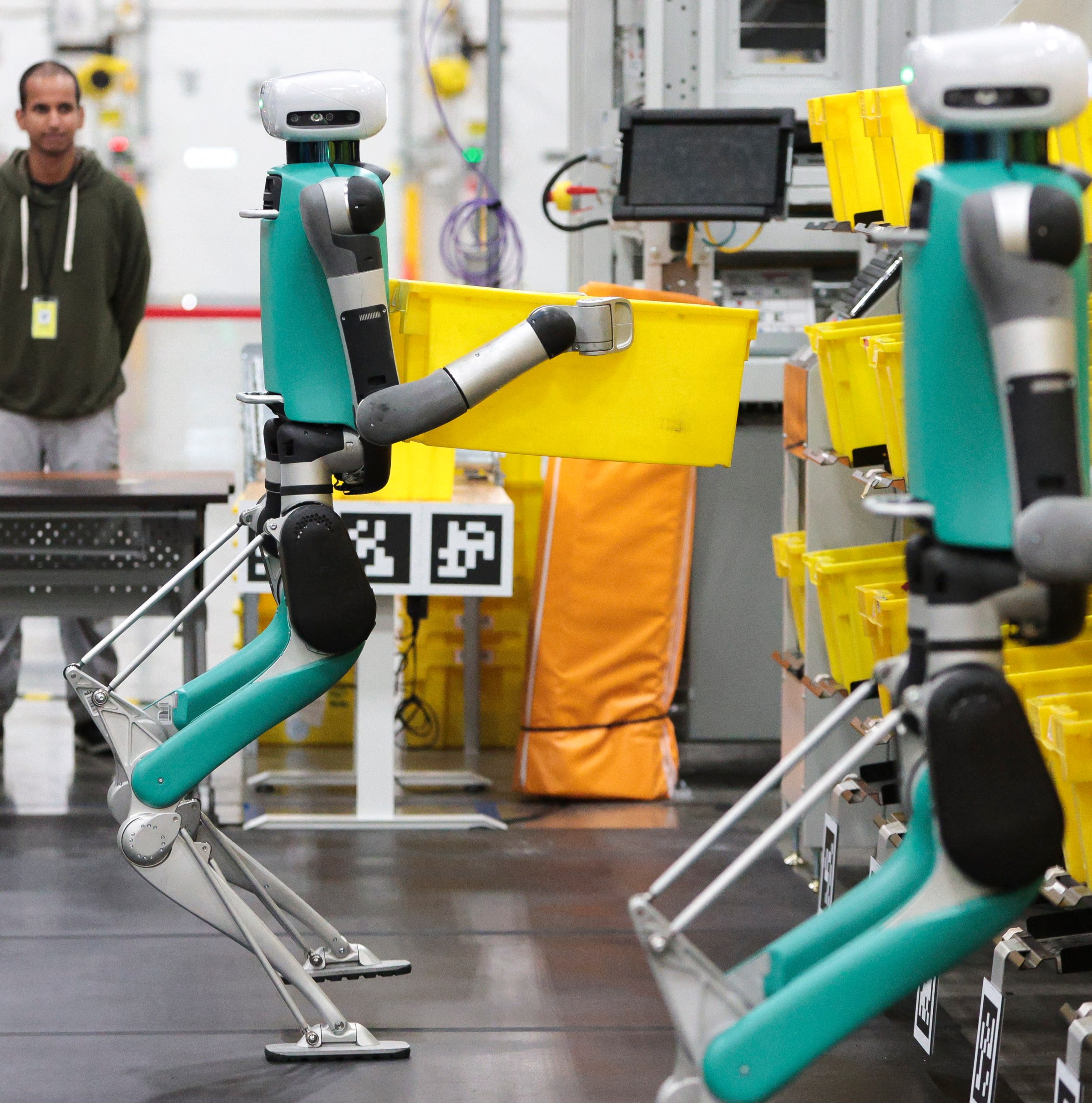
Amazon's Automation Endgame: Replacing 600,000 Workers While Pretending the Robots Are Friendly
Leaked documents reveal Amazon's systematic plan to eliminate human labor through robotics, while carefully managing the public relations fallout.
Amazon’s leaked automation documents reveal more than just corporate strategy, they expose a fundamental tension in the digital economy. While the company prepares to eliminate hundreds of thousands of jobs through robotics, it’s simultaneously crafting a narrative that carefully avoids words like “robots” and “automation.” This isn’t just technological evolution, it’s a deliberate reshaping of American labor with corporate spin baked directly into the blueprint.
The Numbers Behind the Robotic Takeover
The scale of Amazon’s automation ambitions is staggering by any measure. Internal strategy documents obtained by The New York Times show the company believes it can avoid hiring more than 160,000 people in the United States it would otherwise need by 2027. That’s just the near-term impact, executives told Amazon’s board they hope robotic automation would allow the company to continue avoiding workforce growth despite expecting to sell twice as many products by 2033.
The most alarming projection? Amazon’s robotics team has an ultimate goal to automate 75 percent of its operations, translating to more than 600,000 people whom Amazon won’t need to hire over the coming years. That’s nearly half of Amazon’s current 1.2 million U.S. workforce that simply won’t exist in this automated future.

The financial motivation is equally colossal. Amazon’s automation plan, now reduced to less than $10 billion in costs, is projected to deliver $12.6 billion in savings from 2025 to 2027. At the operational level, this translates to saving about 30 cents on each item that Amazon picks, packs and delivers to customers, a significant margin in an industry where pennies determine profitability.
The PR Playbook: Rebooting Reality Through Language
What’s perhaps more revealing than the automation targets is Amazon’s meticulous approach to managing public perception. The company has developed specific linguistic protocols that read like corporate propaganda straight out of a dystopian novel.
Internal documents show Amazon contemplates avoiding using terms like “automation” and “A.I.” when discussing robotics, instead preferring benign alternatives like “advanced technology” or replacing “robot” with “cobot”, a term deliberately chosen to imply collaboration with humans rather than replacement of them.
This isn’t accidental wording. It’s strategic communication designed to soften the blow of massive workforce reduction. While the robots eliminate jobs, Amazon plans to build its image as a “good corporate citizen” through greater participation in community events such as parades and Toys for Tots, creating the appearance of community investment even as it systematically reduces employment opportunities.
As one astute observer noted in discussions about the leak, this linguistic sleight-of-hand feels deeply intentional: “They say don’t copy code without explicit permission…” becomes irrelevant when you’re copying human labor patterns and replacing them with automation.
The Automation Assembly Line: Meet the Workforce Replacements
Amazon’s robotic revolution isn’t some distant future concept, it’s already operating at scale. The company has methodically categorized its operations into six types of automation: movement, manipulation, sorting, storage, identification and packing. They’re pursuing “world-class capability in each of those” areas, according to Amazon Robotics chief technologist Tye Brady.
At Amazon’s most advanced warehouse in Shreveport, Louisiana, the template for future robotic fulfillment centers, the transformation is already visible. Once an item is in a package, a human barely touches it again. The facility employs a thousand robots, allowing it to employ a quarter fewer workers last year than it would have without automation. Next year, as more robots are introduced, Amazon expects to employ about half as many workers there as it would without automation.
The robotic workforce includes specialized systems with names straight out of mythology:
- Sparrow: A robotic arm that looks into bins of items, picks the desired product, and places it in another bin
- Proteus: A tortoise-looking robot that slides under carts and autonomously carries them to shipping docks (complete with smile-shaped lights when navigating around workers)
- Cardinal: A beefy robotic arm that grabs sealed boxes and stacks them into carts, playing “Tetris very nicely” according to facility managers
- Hercules and Pegasus: Updates to Amazon’s original Kiva robots that move heavy carts and shuttle packed orders

The Human Cost and Demographic Disruption
The impact of this automation push extends far beyond corporate balance sheets. Amazon’s warehouse workers are about three times as likely as typical American workers to be Black, meaning communities of color could bear the brunt of this workforce transformation.
The Stone Mountain, Georgia facility provides a sobering case study. This warehouse currently employs roughly 4,000 workers, but once robotic systems are installed, internal analysis projects it will process 10 percent more items while needing as many as 1,200 fewer employees. Documents also show that after the retrofit, the facility will depend more on temporary employees than full-time staff.
What makes this particularly insidious is the silent nature of the workforce reduction. Amazon isn’t planning mass layoffs, instead, it plans to shrink its workforce through attrition. While a 28-year-old Black man near the Stone Mountain facility desperately refreshes Amazon’s hiring website every 10 seconds looking for work, he doesn’t realize the company hasn’t posted a single job listing there for five months because they’re systematically reducing headcount through non-replacement.
As MIT professor Daron Acemoglu, who won the Nobel Prize in economic science last year, puts it: “Once they work out how to do this profitably, it will spread to others, too.” He warns that if Amazon’s plans pan out, “one of the biggest employers in the United States will become a net job destroyer, not a net job creator.”
The Economic Paradox: Who Buys Amazon’s Products?
The automation strategy creates an inherent economic contradiction that’s impossible to ignore. As one observer pointedly asked: “Who is going to buy from Amazon when the economy collapses?”
Amazon’s response to this paradox focuses on retraining and new job creation. Udit Madan, who leads worldwide operations for Amazon, argues that the company has “a long history of using the savings from automation to create new jobs”, pointing to recent pushes to open more delivery depots in rural areas. Amazon’s mechatronics apprenticeship program has trained almost 5,000 people since 2019, with robotics technicians making at least $24.45 an hour compared to the $19.50 starting wage for regular hourly workers.
But these technician roles represent a fraction of the positions being eliminated. At the Shreveport facility, more than 160 people work as robotics technicians, impressive until you consider they’re supporting automation that will eventually eliminate thousands of similar jobs across the company’s network.

The Ripple Effect Across American Industry
Amazon’s automation strategy doesn’t exist in a vacuum. As the nation’s second-largest private employer, its approach serves as a model for other companies like Walmart (the largest private employer) and UPS. The company that transformed the U.S. workforce by creating booming demand for warehousing and delivery jobs now stands to reverse that trend.
The broader implication is that blue-collar jobs throughout the country could become “more technical, higher paid and more scarce”, a transformation that sounds positive until you consider the number of workers who won’t make that transition.
Some critics speculate this has been Amazon’s long-game all along. As one commenter observed: “I’m pretty convinced that full automation has been their goal for a long time, they just miscalculated how long it would take to get there. So in the meantime they put people in positions designed for robots, but already treat them like they are robots.”
The question now is whether other major employers will follow Amazon’s lead, creating a domino effect across the logistics and retail sectors. When the company that pioneered massive warehouse employment decides human workers are the problem rather than the solution, every logistics-dependent industry takes notice.
The Inevitable Automation Calculus
Amazon’s automation drive represents more than just corporate efficiency, it’s a fundamental reevaluation of human labor in the digital age. The company’s internal documents reveal not just technological ambition but a comprehensive strategy for managing the societal fallout, complete with linguistic framing and community engagement designed to soften the impact.
The numbers tell a stark story: 600,000 jobs that won’t exist, $12.6 billion in savings, and a workforce transformation that could leave entire communities economically stranded. As Amazon builds its template for the automated future in Shreveport and prepares to replicate it across 40 facilities by 2027, the only question remaining is how quickly the rest of corporate America will follow.
The robots aren’t coming, they’re already here, and they’re not just collaborating with humans. They’re systematically replacing them, while corporate communications departments work overtime to convince us otherwise.



